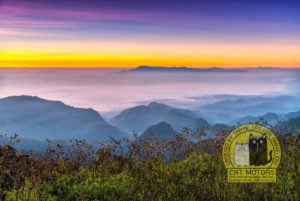10 Reasons To Visit Wat Chiang Man in Chiang Mai
A holiday to northern Thailand is always a good idea, albeit less popular. There are more than a few things to explore and discover, such as delightful food, local culture, magnificent waterfalls, mountain views, unbelievable landscapes, and so much more. Among that, there are interesting provinces like Chiang Mai – home to over 300 temples that you can visit.
It can get overwhelming deciding which temples you should visit within a limited time to ensure you get the most profound experience. While there are several special ones, Wat Chiang Man is one of the most significant temples and a must-visit in Chiang Mai city. Below are all the reasons why.
Wat Chiang Man Is The First Temple In Chiang Mai
If you are looking for a significant experience visiting temples in northern Thailand, it would only be fitting to check out the first and oldest temple in Chiang Mai city. It is a historical site with ancient structures and so much to discover. Everything about Chiang Mai and its culture began at the Wat Chiang Man complex. It is also a royal temple of Chiang Mai.

The temple was built in 1297, more than 700 years ago. King Mangrai of Lanna Kingdom moved there when he started the construction of old Chiang Mai city and used the temple to camp and oversee the building process. Wat Chiang Man also houses several ancient artifacts that hold the utmost significance to Buddhism’s culture, religion, and history.
Chedi Chang Lom
There are several structures at Wat Chiang Man, one of them being the chedi, which is the oldest structure in the complex. A Chedi is a Buddhist Pagoda. It is said to be a monument built over mortal, cremated remains of a specific important person in the Buddhist religion. The Wat Chiang Man Chedi also holds the hair of a Buddha inside the chamber.
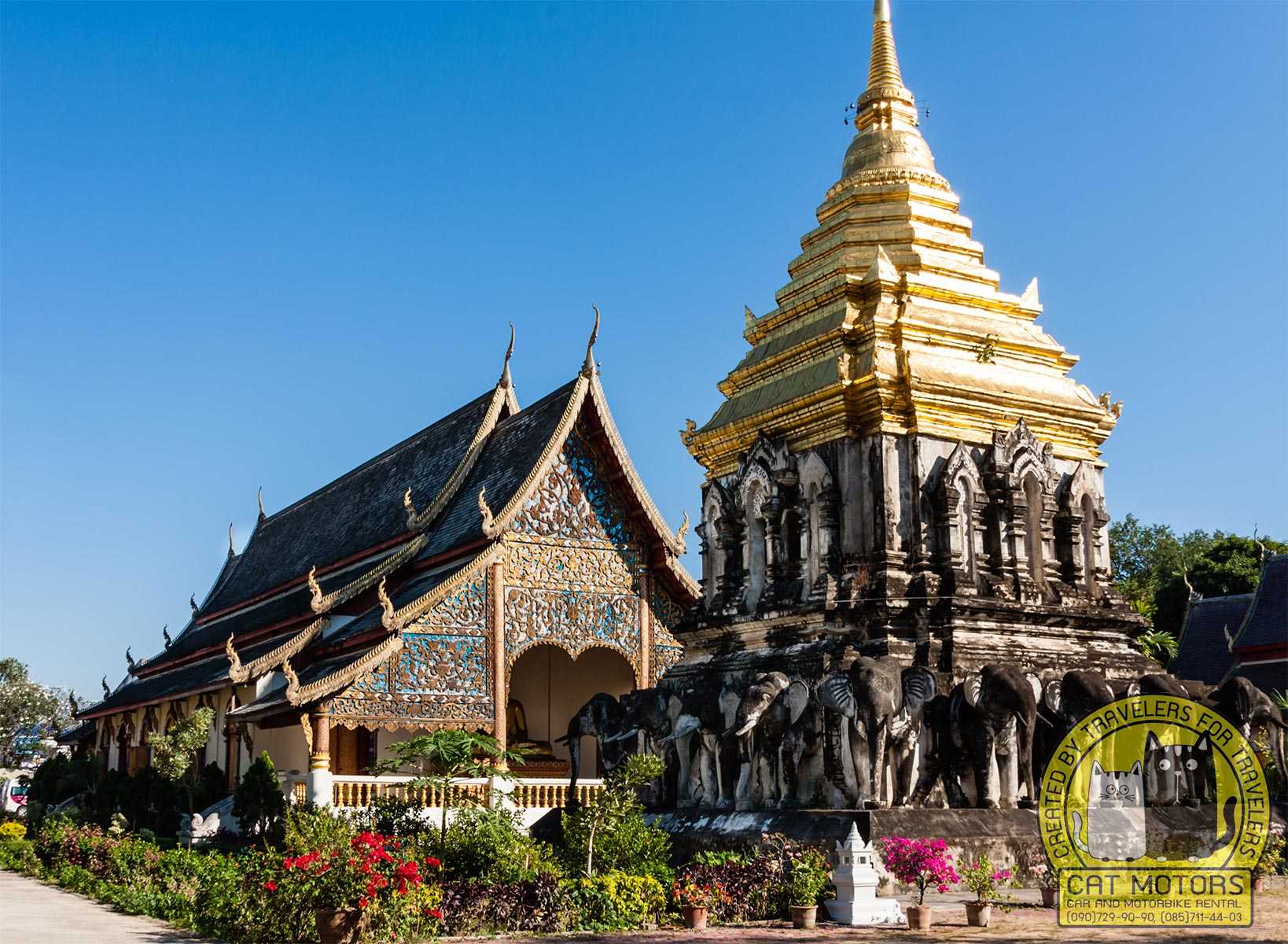
Visitors are not allowed to walk up the stairs or enter the chedi. The royal Chedi at Wat Chiang Man visually portrays every bit of history with its washed-out paint and ancient aesthetic. The design of the architecture originates from Sri Lankan and Lanna styles. It has a square foundation that supports its second tier, made with gray stone.
The second tier is surrounded by 15 elephants that look like they are emerging from the structure while supporting the upper layers of the chedi. The elephants serve as a representation of that idea because it means they are the guardians of the relics that the chedi holds. The top of the chedi is a beautiful golden stupa (vertical shaft) that stands tall, looking new, contrasting the lower layers.
Main Viharn
The Wat complex hosts two viharns. A viharn is a hall for worship and prayers. Everyone can enter the viharns, explore, learn, donate, and pray. The main viharn is also the older of the two temples. Additionally, it is the site where King Mangrai set up camp. The first thing you notice before entering the main viharn is the three-tiered roof and beautiful golden wood carvings.
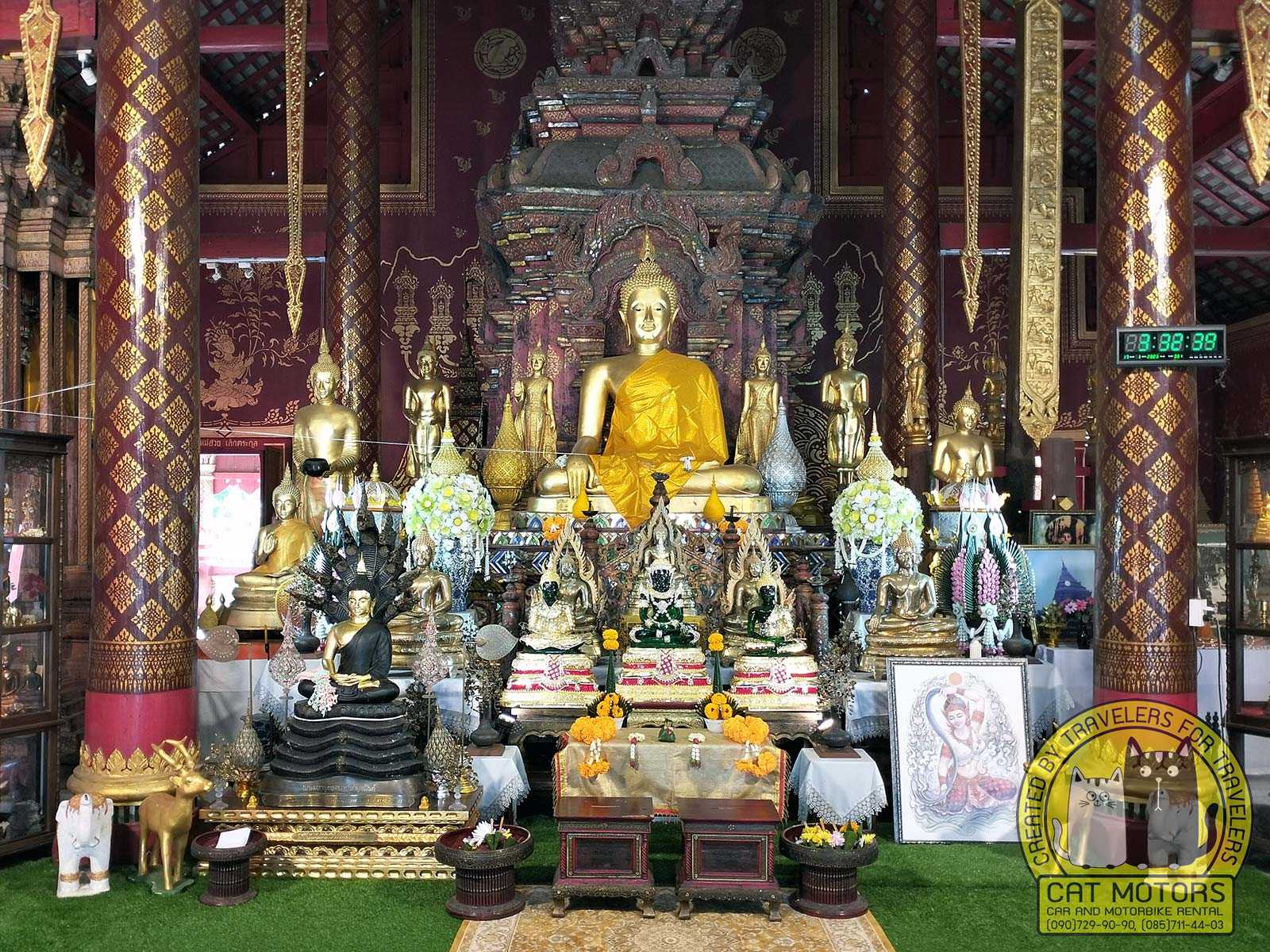
The worship hall is stunning inside; however, it is a renovated version that occurred in the 1920s by the famous monk Khru Ba Srivichai. One of the significances of this old viharn is that it is home to the oldest Budhha image from Chiang Mai. The image features a standing Buddha holding an alms bowl with an inscription dating back to 1465.
Inside the Viharn, you can also find several Buddha statues in a line holding alms bowls with the days of the week names. You can place your donations inside the day of the week you visit or were born to serve as an offering for your prayers. The same concept is also found right outside the hall.
New Viharn
The second viharn is the newer structure to the north of the complex. It is smaller than the main worship hall but also holds a weight of significance. Nagas – mystical snakes – guard the entrance at the stairs. The new viharn has a two-tiered roof with wood carvings in gold and green.
The walls inside the new viharn are decorated with artwork that tells stories of the life of a Buddha. The paintings are colorful, intriguing, and soul-touching, with intricate details that will have you staring at them for longer than you realize.

Another feature inside the old worship hall is the sizeable central Buddha statue, in front of which prayers can be offered. The area also has other images and objects with signages of their significance.
Behind the large central Buddha, enclosed in a vault that looks like a massive throne, in which the two incredibly important relics are safely kept. The images are carved Buddhas, said to hold great power. The images are namely: Phra Sae Tang Khamani and Phra Sila Buddha.
Phra Sae Tang Khamani
This carved image belonged to queen Chamadevi from Lopburi. It survived the burning and destruction of Haripunchai by King Mangrai in 1281 and is since believed to have protective powers. Buddhists attribute its ability to protect them, their temple, and the city against disasters. It is better known as the Crystal Buddha because it was made from quartz crystal.
Phra Sae Tang Khamani, also known as Phra Setangamani, is believed to have been created in the year 200, making her over 1800 years old.
Phra Sila Buddha
The Phra Sila carved image is better known as the Marble Buddha. It is a bas-relief stele carved in stone. The image features a standing Buddha taming an elephant. This relic was believed to be created in Sri Lanka and is over a thousand years old.

Unfortunately, you can not see these ancient statues close up, as they are placed high, in a special glass box enclosed by a metal lattice. But you can see them from afar by following the sign on the territory of the Chiang Man temple, which is located next to the new viharn.
Buddhists believe the carved image holds the power to bring rain; therefore, it is the focus of the Songkran festival held from 1-5 April, at the end of the dry season.
Ubosot (Ordination Hall)
Like most Buddhist temples in Thailand, a structure next to or nearby called the Ubosot is common. It is an ordination hall for monks and is used for other religious rituals and prayers. Some temple Ubosots are open to visitors (males only), but Wat Chiang Man Ubosot provides no visitor access.
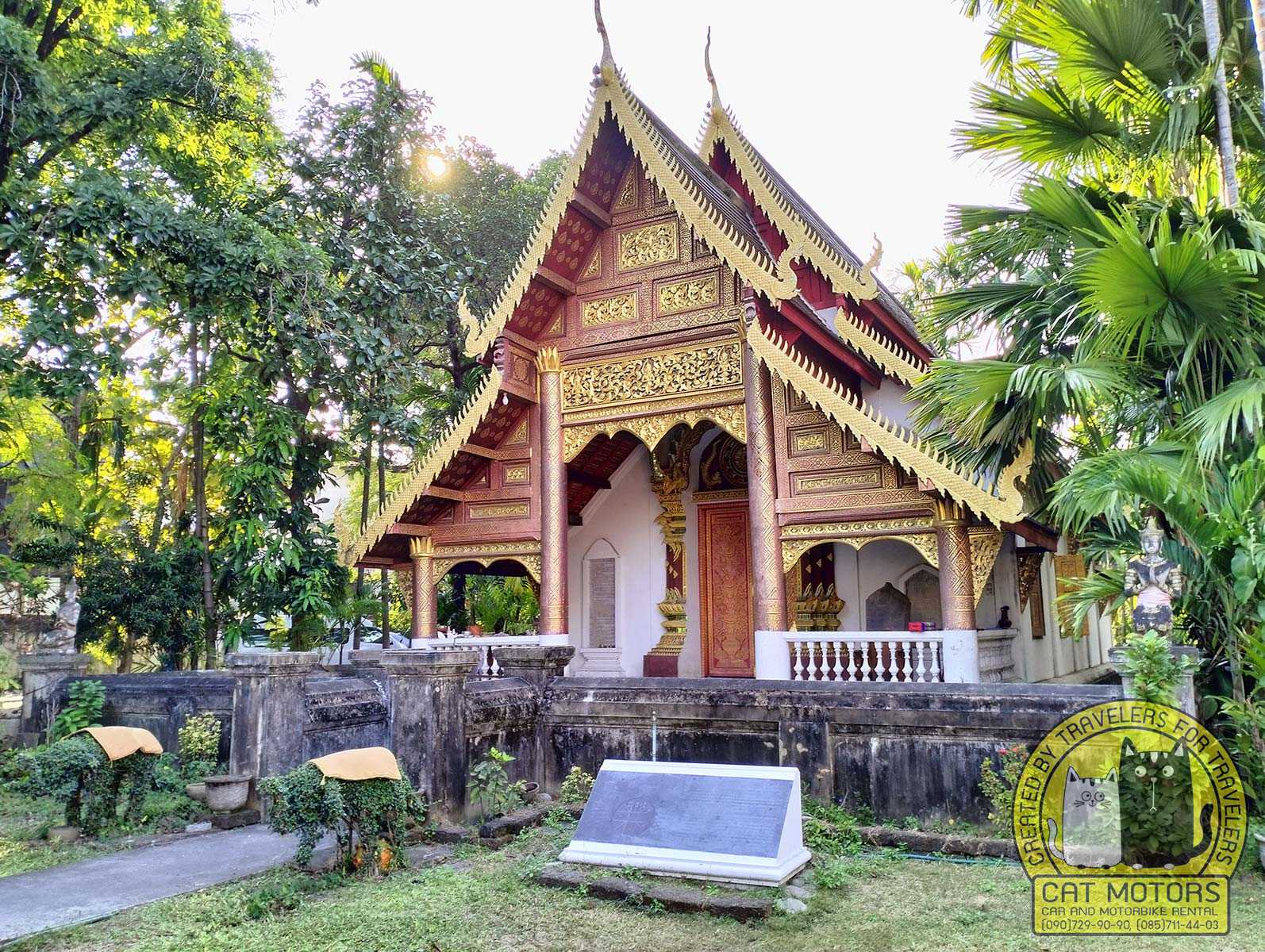
It is said that the Ubosot was restored in 1571, and during King Kawila’s reign in 1805, the current structure was constructed. A stone stele stands in front of the Ubosot and holds information about the foundation of Chiang Mai’s history. The inscription identifies the 12th of April 1296 as the founding year of Chiang Mai city.
Ho Trai (Temple Library)
The temple library was initially located between the main viharn and the chedi. It was later turned into a raised repository and placed in the middle of the lotus pond to protect the Buddhists’ scriptures, like palm leaf manuscripts, from floods, pesticides, and termites.
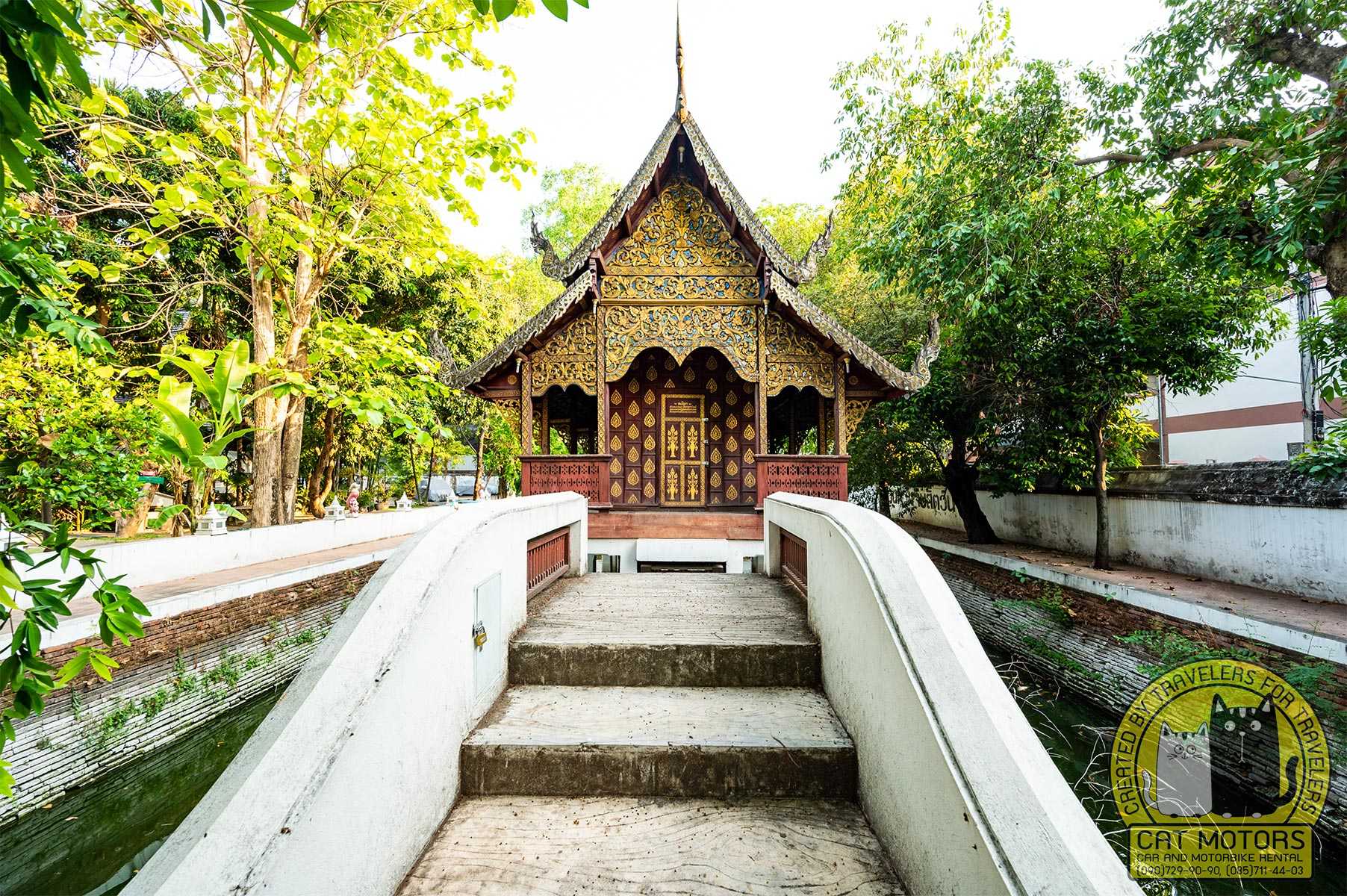
At the time of this writing, the bridge leading to the library, which is located in the middle of the monastery pond, is under reconstruction.
The bridge leading to the structure is not open, and visitors are not allowed access. But it is interesting to notice and realize how the monks preserve and protect their religious items. You can also catch sight of the fish in the pond while pondering the idea of a library on stilts.
Wat Chiang Man Garden
The serene garden is one of the many reasons people leave Wat Chiang Man complex with a feeling of love and healing. While walking from one structure to the next, you can admire the greenery of the grass, trees, and carved trees in the shapes of elephants. The garden is well-kept and clean and provides a peaceful environment.
You can enjoy time sitting on the grass and meditating or resting. There is even a tree with hanging boards featuring virtuous quotes and words of inspiration. You will undoubtedly end your visit to Wat Chiang Man with a sense of inner peace, healing energy, and beautiful pictures.
The Streets Of Chiang Mai
A genuine cultural, local, and immersive experience of northern Thailand must entail taking your time walking the streets of the towns. The Wat complex is located on the North East corner of the old walled town, within the city walls, in Amphoe Mueang, the capital district of Chiang Mai province.
The streets to and from Wat Chiang Man are an experience in itself and more reason to make your way to the temple complex. You can make short stops along the way to indulge in street food, local shopping, tasteful coffee, and awe at the graffiti on the walls.
Whether you rent a motorbike or journey on foot through the town, not taking advantage of what the street of Thailand offers and engaging with the locals will take away from the unique experience of understanding and enjoying local Thailand culture and tradition.
Summary
If you want an unforgettable, educational, significant encounter with the rich history of Buddhism and how the city of Chiang Mai came into existence, add Wat Chiang Man to your must-visit list of temples in northern Thailand.
Video Review
FAQ
Wat Chiang Man, one of the oldest and most iconic temples in Chiang Mai, Thailand, was built in 1296. It is believed to be the first temple ever constructed in the city and has become an important part of its history and culture.
The temple is said to have been commissioned by King Mengrai, the founder of Chiang Mai. The king wanted a place of worship for his people, as well as a symbol of his own power and authority over the city. He chose a site along the Ping River that was close to his palace and had great spiritual significance to the local people.
The temple was built with intricate detail and careful planning. It featured two chedis (stupas) made of brick and plaster, which are still standing today. The walls were adorned with delicate carvings depicting scenes from Buddhist mythology, while the interior contained many statues of Buddha, as well as numerous other sculptures related to Buddhism.
Today Wat Chiang Man stands as a testament to the skill and craftsmanship of those who built it centuries ago. It is an important part of Chiang Mai’s history and continues to be a popular destination for both locals and tourists alike who come to marvel at its beauty and pay their respects to Buddhism.
For those looking to explore the area around Wat Chiang Man, there is no shortage of activities and attractions to enjoy. Just a short walk from the temple lies Wat Chedi Luang, another important temple in Chiang Mai. This temple was built in the 14th century and is known for its impressive architecture, including a large pagoda that stands at over 90 feet tall. Wat Phra Singh and Three Kings monument are also within walking distance.
Nearby, you can also visit the Chiang Mai City Arts & Cultural Center, which houses a wide variety of exhibits related to local history and culture. The center also hosts regular events such as traditional Thai dance performances and lectures on Buddhism.
If you’re looking for something more active, there are plenty of outdoor activities to choose from as well. You can take a boat ride along the Ping River or go for a hike in one of the nearby national parks. There are also plenty of markets and shops in the area where you can pick up souvenirs or sample some of the delicious local cuisine.
Wat Chiang Man is the oldest temple in Chiang Mai, established by King Mengrai in 1297 when the city of Chiang Mai was founded. The temple, therefore, holds immense historical significance as it provides a window into the region’s past.
Wat Chiang Man exhibits classic Lanna style architecture, unique to northern Thailand, Laos, and some regions of Burma. Its distinctive features include the tiered roof and elaborate wood carvings. The temple complex houses two important structures: the larger main viharn and the smaller Chedi Chang Lom, which is characterized by its base surrounded by elephant statues.
The temple was built by King Mengrai. It was constructed at this particular location because it was believed to be auspicious and suitable for the establishment of the new city, Chiang Mai.
Yes, the most intriguing one being the legend surrounding the Crystal Buddha, or Phra Sae Tang Khamani, housed in the temple. It is believed to possess the power to bring rain, and thus was invoked during periods of drought.
Festivals such as Songkran (Thai New Year), Loy Krathong, and Makha Bucha Day are celebrated with much fervor at Wat Chiang Man, with locals and tourists participating in the ceremonies.
Monastic life plays a central role in the cultural practices at Wat Chiang Man. The temple serves as a place of learning and meditation for monks, and visitors often have opportunities to engage in discussion sessions with them.
The Elephant Chedi or Chedi Chang Lom is significant for its unique design featuring life-sized elephant statues. The Crystal Buddha, believed to bring rain, holds religious importance and is revered by the locals.
Wat Chiang Man is more than just a religious center; it plays an integral role in the community. It is a place of learning, spiritual guidance, and a venue for festivals and community gatherings.
Yes, as with any temple in Thailand, it’s important to dress modestly (shoulders and knees covered), speak softly, and show respect to the monks and the Buddha images.
Yes, guided tours are available. While some can be booked online, you can also arrange them through your hotel or a local travel agency in Chiang Mai.
Early morning or late afternoon are ideal to avoid the heat and larger crowds. This will also give you an opportunity to see monks during their daily routines.
Beyond Wat Chiang Man, Chiang Mai is bustling with cultural, historical, and culinary attractions. Here are some:
Chiang Mai City Arts & Cultural Centre: A place to get an in-depth understanding of Chiang Mai’s history, culture, and traditions. It’s just a short walk from Wat Chiang Man.
Three Kings Monument: A significant landmark in Chiang Mai, representing the three kings who are believed to have founded the city.
Sunday Walking Street: If you’re in Chiang Mai over the weekend, don’t miss the Sunday Walking Street – a lively market full of food stalls, local crafts, and street performers.
Wat Chedi Luang: Another must-see temple, known for its large ruined chedi, which was partially destroyed in an earthquake but remains a magnificent sight.
Tha Pae Gate: It’s an ancient gate and one of the most famous landmarks in Chiang Mai. Here you’ll often find street entertainers, food vendors, and locals enjoying the evening.
Set off on an unforgettable journey through Northern Thailand with our extensive travel guides. They showcase the best scenic routes and local highlights. For those ready to begin, explore our motorcycle rental in Chiang Mai. Ensure you review our terms and conditions to be well-prepared. These resources will help you confidently navigate mountain trails and quaint villages.
Our travel advice sections provide crucial tips on staying safe and maximizing your travel experience. Learn about the best times to visit key attractions, participate in local festivals, and manage various road conditions. These insights will enrich your journey, making it both enjoyable and secure. Let us lead you through Northern Thailand’s stunning landscapes and vibrant culture, ensuring your adventure is truly memorable.
Was this post useful for you?
You can rate it by clicking on a star
Average rating / 5. Vote count:
No votes so far! Be the first to rate this post.
We are sorry that this post was not useful for you!
Let us improve this post!
Tell us how we can improve this post?
- Author: Natcha Lindberg
- Updated: March 26, 2025
- No Comments




